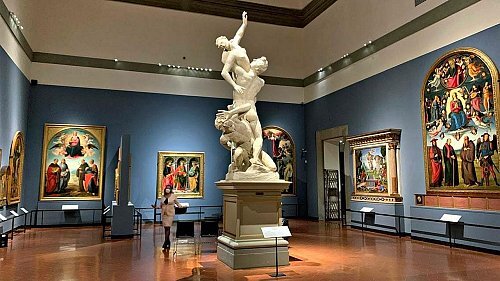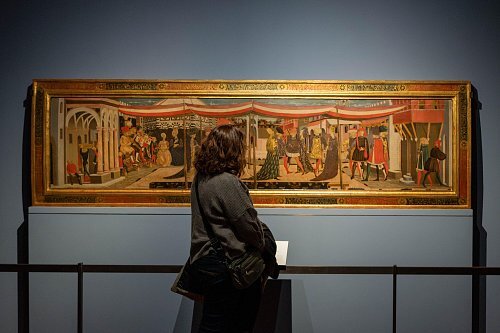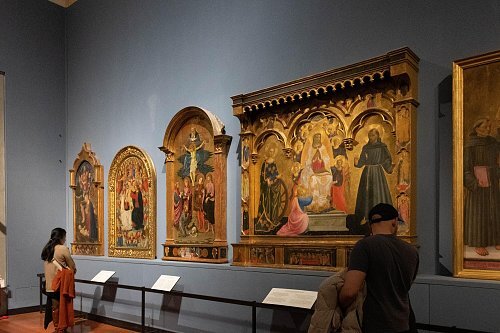Salão Colosso

Os visitantes entram no Salão do Colosso, na Galeria, que foi totalmente redesenhada desde dezembro de 2013.
O primeiro passo do visitante no itinerário da exposição do museu é dentro do Salão do Colosso, uma sala ampla cuja peça central é o belo esboço em terracota de Giambologna, O Rapto das Sabinas. Este salão permite ver pinturas florentinas do século XV e início do século XVI. Uma pequena sala recém-criada, que se estende do Salão do Colosso, foi projetada para permitir a apreciação exclusiva das obras dedicadas ao século XV. Obras-primas como “A Tebaida”, de Paolo Uccello, e “Cassone Adimari”, de Scheggia (irmão de Masaccio), poderão ser vistas aqui.
A sala recebeu esse nome no século XIX, quando exibia uma cópia em gesso de uma estátua antiga — especificamente uma dos Dioscuri de Montecavallo (Castor e Pólux) — que não está mais em exibição na galeria.
Atualmente, no centro da sala, encontra-se o modelo em gesso da grande escultura em mármore de Giambologna, “O Rapto das Sabinas”, realizada por volta de 1580.
Giambologna fez este modelo para mostrar sua grande habilidade; foi a primeira vez que um conjunto coeso de três figuras esculpidas em um grande bloco de mármore pôde ser visto de diferentes ângulos. A peça original completa foi concluída em 1582 e exposta sob a Loggia dei Lanzi, na Piazza della Signoria.
Na mesma parede da entrada
O gesso de Giambologna está entre um enorme tesouro de arte religiosa que remonta ao período gótico tardio e ao início do Renascimento, do século XV ao início do século XVI. O formato minúsculo das inúmeras pinturas em painéis penduradas na parede certamente chama a atenção. Esta parede exibe obras de mestres como Paolo Uccello, Perugino, Filippino Lippi, Domenico Ghirlandaio e Botticelli.
À primeira vista, pode parecer um pouco grande, mas não se preocupe, para melhor apreciar esta impressionante coleção, há duas peças principais que vale a pena procurar na parede, entre o mar de arte renascentista: e a outra é a peça central; o painel retangular frontal de um baú, Cassone Adimari.
Este painel faz parte de um par de baús de casamento ligados à família Adimari e representa um casamento renascentista florentino arquetípico. Apresenta ruas centrais, monumentos famosos, com o Batistério à esquerda, e brocados suntuosos que personificam a tradição e a prosperidade das famílias nobres de Florença na década de 1450.


A parede esquerda
À esquerda do peito, encontra-se a segunda obra-prima: um pequeno painel, atribuído a Botticelli, conhecido como A Madona do Mar. Este título provém de uma paisagem marítima ténue que se distingue ao fundo; a sua verdadeira beleza reside nos detalhes dourados e nos símbolos que compõem as duas figuras. A romã segurada pelo menino Jesus simboliza a paixão de Cristo. A estrela — “Stella Maris” — que Maria usa em seu manto azul escuro, dá outra ligação desta obra ao mar. Na Idade Média, acreditava-se que quando se falava de “Maria”, estava-se se referindo ao mar, pois mare é a palavra italiana para mar. Portanto, Stella Maris se torna um símbolo para Maria com base nas antigas visões deste nome judeu “Myriam” (Maria) e também a relaciona com o oceano.
A ala esquerda atual do Salão Colossus exibe seis retábulos do século XV dispostos em ordem cronológica para mostrar como a escola florentina se desenvolveu. Começa com um painel quadrado feito por Andrea di Giusto em 1437 e termina com a habilidade totalmente desenvolvida do famoso Domenico Ghirlandaio no final do conjunto.
Essencial para toda a obra é a grande Trindade de Alesso Baldovinetti, pintada em 1470 para a Igreja de Santa Trinita, em Florença. Por trás de véus elegantemente drapeados e ornamentados com pérolas, revela-se o mistério da Trindade — Deus Pai, Cristo e o Espírito Santo — apoiada por anjos. A figura de Cristo na cruz está diante de Deus Pai. Entre suas cabeças, uma pomba branca representa o Espírito Santo. Anjos querubins vibrantes cercam essas três figuras centrais, todas emolduradas por uma forma amendoada. Um crânio repousa sob a cruz, um símbolo religioso comum da redenção humana. Que, através de Seu sacrifício, esse sangue alcance o crânio de Adão, para que todos os seus descendentes tenham a mesma oportunidade de ser libertos do pecado original.
À direita da Trindade, numa obra famosa o suficiente para chegar até nós pelo nome, está o Retábulo de Trebbio, de Botticelli, que retrata uma Santa Conversação, na qual a Virgem e o Menino estão magnificamente em pé dentro de um grande espaço arquitetônico ao lado de seis santos de diferentes épocas. Este painel provém da villa dos Médici em Trebbio e foi provavelmente encomendado por Lorenzo di Pierfrancesco Medici. O patrocínio da família Médici é inequivocamente simbolizado pela inclusão dos seus santos protetores, São Cosme e São Damião, aqui retratados em longas e elegantes vestes roxas.
Na extremidade esquerda desta parede encontra-se a digna obra de Domenico Ghirlandaio representando Santo Estêvão, com São Tiago e São Pedro ao seu lado (1493). O toque do grande mestre é evidente na grandiosidade destas três figuras esculturais que se erguem dramaticamente sobre um fundo de nichos monumentais pintados. Ghirlandaio convidou Michelangelo para sua oficina por um curto período, quando Michelangelo tinha apenas 14 anos. Essa relação acabou sendo crucial para Michelangelo ao longo de sua vida artística e influenciou suas pinturas em painéis e afrescos, especialmente durante os anos em que trabalhou na Capela Sistina (1504-08).

A parede certa
O espaço recém-concebido permite aos visitantes contemplar três grandes retábulos dispostos ordenadamente em torno do modelo em gesso de Giambologna. Desde dezembro de 2013, o lado direito desta sala abriga o magnífico painel de Perugino representando a Assunção da Virgem (1500), acompanhado pela Ressurreição de Raffaellino del Garbo e a Deposição de Filippino Lippi (1504-08).
O retábulo principal, uma das melhores obras de Pietro Perugino, foi encomendado em 1500 pelos monges de Vallombrosa para sua igreja. Ele traz assinaturas inscritas na parte inferior, claramente visíveis no painel mais baixo: “PETRVS PERVGINVS PINXIT A.D. MCCCCC”. O tema principal é a Assunção da Virgem Maria rodeada por um coro de anjos que cantam e tocam diversos instrumentos, como harpas, violinos e guitarras, contra um fundo de cortinas em tons suaves. Abaixo deste tema principal, encontram-se quatro santos pintados por Perugino como padroeiros da devoção relacionada com os monges camaldulenses.
À sua direita, apresenta-se o belo São Miguel Arcanjo com uma armadura muito rica e brilhante. Longas vigas de madeira visíveis na parte inferior do painel sustentam um grande painel de madeira. Pintura emoldurada por uma predela e dois retratos de monges de Vallombrosa; montagem final concluída em dezembro de 2013.
À esquerda da Assunção, um suave encanto de fitas cor-de-rosa na Deposição de Filippino chamará sua atenção. Este painel foi iniciado por Filippino Lippi em 1504 e posteriormente concluído por Perugino após a morte de Lippi; originalmente, encontrava-se na Igreja da Santissima Annunziata, em Florença, onde Perugino terminou toda a parte inferior em 1507. Os diferentes estilos entre os dois níveis marcam de forma bastante distinta uma sensação de divisão.
A parte superior mostra a exploração típica de Filippino do movimento e do dinamismo, com várias figuras em equilíbrio precário em torno da cruz, bem como fitas que esvoaçam de forma inconfundível.
Os detalhes das intervenções

Se não fosse pelo fechamento temporário e posterior realocação das obras, não teria sido possível realizar uma análise aprofundada do ambiente e da documentação sobre o estado de conservação das peças. O museu também aproveitou esse período para planejar uma manutenção específica voltada para a conservação e restauração, quando necessário. De fato, esses trabalhos tiveram que ser realizados por restauradores especializados, trabalhando sob um plano de ação de manutenção elaborado e coordenado por Eleonora Pucci, diretora restauradora da Galeria da Academia. Três peças tiveram que permanecer no local devido ao seu tamanho e fragilidade: o grupo escultórico do Rapto das Sabinas, o grande retábulo da Assunção da Virgem, de Pietro Perugino, e a Disputa dos Padres da Igreja sobre a Imaculada Conceição, de Giovanni Antonio Sogliani; estas foram protegidas por estruturas concebidas especialmente para o efeito. Todas as outras obras foram protegidas e transferidas para áreas onde são realizadas exposições temporárias, mas de forma que as pessoas pudessem continuar a apreciá-las. Assim, apesar do fechamento, o acesso às obras de arte não foi impedido.
Além das intervenções de limpeza, alguns dos painéis valiosos, conhecidos pelo seu estado de conservação frágil e pequenas dimensões, foram protegidos com vidro de exposição imperceptível a olho nu. Este vidro mantém eficazmente os agentes climáticos externos afastados da obra de arte, não colocando em risco alterações na superfície pictórica nem danos no suporte. Entre as obras em restauração, destacam-se a Ressurreição de Cristo, de Raffaellino del Garbo, com uma grande moldura de madeira, que voltou recentemente à posse do museu, e a tempera su tavola di Giovan Francesco da Rimini raffigurante San Vincenzo Ferrer
As molduras douradas também foram muito apreciadas, e três delas foram submetidas a restauração após uma avaliação adequada do seu estado de conservação e das questões relacionadas. Trata-se da moldura da Madonna del Mare, de Sandro Botticelli, da moldura redonda da Madonna e Menino com São José e São João, de Franciabigio, e da moldura que completa a Adoração do Menino com Dois Anjos e São José, de Lorenzo di Credi. As medidas de restauração realizadas especificamente para as necessidades de conservação incluíram a limpeza para obter uma aparência uniforme da superfície, a consolidação da película dourada e dos elementos em talhe, pequenos reparos no gesso e a integração de folhas de ouro onde necessário, utilizando técnicas relacionadas com o douramento original, da forma mais viável de acordo com as diretrizes de gestão do museu.
No trabalho estrutural liderado pela arquiteta Claudia Gerola, o projeto começou com a restauração e reforço das vigas de madeira do salão. Durante esta fase, foram feitas modificações e substituições nos sistemas existentes, nomeadamente sistemas especializados de deteção de incêndios anti-intrusão, sistemas elétricos e mecânicos, juntamente com a UTA - Unidade de Tratamento de Ar. Também foi feita a remoção de acúmulos de água que anteriormente causavam infiltrações notáveis no salão abaixo, bem como a remoção de duas camadas de gesso móvel da abóbada. Após a conclusão das tarefas tecnológicas e arquitetônicas, houve um trabalho de revisão do sistema elétrico e dos sistemas de emergência que precedeu a instalação de um novo layout. Painéis revestidos de tecido foram aplicados nas paredes e posteriormente pintados, com a disposição das obras seguindo um novo projeto supervisionado pelo diretor Hollberg. O novo sistema de iluminação foi instalado dentro das paredes perimetrais e na seção central da abóbada. Assim como no restante do museu, foi utilizada tecnologia LED ultramoderna para melhorar a visibilidade das obras e, ao mesmo tempo, garantir economia de energia.
